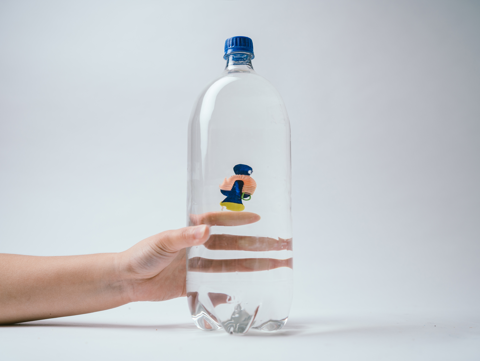Did you know that the air around Nashville weighs about 30 lbs per square inch? That’s twice as heavy as the air is at sea level (14.7 lbs per square inch)! Scientists call this weight pressure. You can’t feel this pressure, though, because our bodies are used to feeling that weight all the time. When you swim, water also pushes on you from all directions, and that pressure increases the deeper you go. Here is a fun experiment you can do at home to see what happens to water and air under pressure!
Materials
- Large, Clear Plastic Bottle with Lid
- Pen Lid with Pocket Clip
- Poster Tack
- Paperclip
- Thin, Colored Plastic (You could use a recycled pop bottle!)
- Scissors
- Water
Activity
1. Attach the paperclip to the pocket clip of the pen cap. If there is a hole in the top of the pen cap, use some poster tack to seal it.
2. Use the thin plastic to create your own little diver. Get creative! Just be sure that the diver is narrow enough to fit through the neck of the bottle.
3. Press the diver on to the bottom of the paperclip using the poster tack.
4. Put the diver in a tall glass of water to test it before putting it inside the bottle. Try to leave an air bubble in the top of the pen so that it can float near the surface of the water. If it is too heavy and sinks to the bottom, remove some of the poster tack.
5. Fill the bottle with water, then carefully add the diver through the neck of the bottle. Screw the lid firmly on the bottle.
6. Squeeze the sides of the bottle and watch what the diver does! What happens when you stop squeezing the bottle? The diver will move slowly at first so be sure to use your scientist-observation eyes.
The Science
The air bubble that is in the pen top reacts to the amount of pressure in the bottle. Once the bottle is sealed, you can increase the pressure inside by squeezing the bottle. Squeezing the bottle pushes the water, which pushes on the air bubble. This causes the diver to sink. When you stop squeezing, or release pressure, the air bubble returns to normal size, pushing the water out and causing the diver to float again!
Further Exploration
- Grab another, smaller bottle (make sure the opening is big enough for your diver) and repeat the experiment. Did the diver sink quicker? Slower? Why do you think that is?
DIVE IN to marine biology all July during Early Explorers with splishy-splashy science every Monday at 9am!





